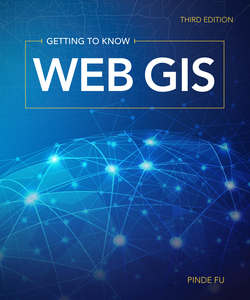Читать книгу Getting to Know Web GIS - Pinde Fu - Страница 4
На сайте Литреса книга снята с продажи.
ОглавлениеPreface
The third edition of Getting to Know Web GIS will help readers begin or continue their journey to learn about, understand, and apply Web GIS.
Web GIS is a promising field with great applicability to e-government, e-business, e-science, and daily life. The societal need for both the web and GIS has generated a strong and increasing demand for good Web GIS professionals. Professors need a lab book to teach Web GIS, and on-the-job professionals need a guide to teach themselves.
This book fits those needs. It teaches readers how to share resources online and build Web GIS apps easily and quickly. The book is a practical manual for classroom lab work and on-the-job training for GIS students, instructors, GIS analysts, managers, web developers, and a broad range of GIS professionals.
The first two editions made this book a best seller and a premier book in the Web GIS field. The new edition is the most current and comprehensive treatment of the Web GIS field, ranging from fundamental concepts to cutting-edge technologies. Universities around the world have adopted this book to teach such courses as Web GIS, Internet GIS, Online Mapping and Information Processing, Web GIS Principles and Applications, and Introduction to GIS.
The third edition builds on the success of the previous two editions to match newer releases of ArcGISSM Online and ArcGIS® Enterprise, with the following updates:
A new chapter on image services and raster analysis
Separate chapters with a more extensive experience using mobile GIS and real-time GIS
Tutorials migrated from ArcMapTM to ArcGIS Pro®, a new and more powerful tool for processing and publishing GIS resources
Newly added frontiers such as big data analysis, the Internet of Things (IoT), virtual reality, augmented reality, and artificial intelligence
New products such as ArcGIS® Arcade, Survey123 for ArcGIS®, Workforce for ArcGIS®, Operations Dashboard for ArcGIS®, Drone2MapTM for ArcGIS®, InsightsSM for ArcGIS®, ArcGIS® API for Python, ArcGIS® GeoAnalytics Server, and ArcGIS® Image Server
In writing this book, I have tried to keep the following principles in mind:
Easy to apply: You do not have to be a developer to build web apps. This book facilitates immediate productivity and teaches how to build engaging web apps without a single line of programming. Even the JavaScript programming chapter is relatively easy to follow, teaching readers how to adapt sample code.
Current: Web GIS technologies advance rapidly. This book teaches state-of-the-art technical skills needed for building applications and managing projects.
Holistic: Unlike books that focus on individual products, this book teaches Web GIS technologies as a holistic platform, from the server side to the browser, mobile, and desktop client side.
Each of the 10 chapters includes the following sections:
A conceptual discussion that gives readers the big picture and the underlying principles
System requirements that help instructors set up the lab
A detailed tutorial with screen captures that confirm progress along the way
Common questions and answers
Assignments that allow readers to practice what they have learned
Online resources with links to videos
This book is the result of the author’s extensive working experience at Esri and teaching experience at Harvard University extension, University of Redlands, Henan University, and University of Texas, Dallas. This course and the set of labs have been well received by these universities and their students. Professors can use this book as the lab book for their Web GIS courses, and professionals at work can use this book for on-the-job training.
While retaining 10 chapters, the third edition has extended tutorials. Professors can break some of the longer chapters into multiple classes and choose which sections to teach based on available class time and software requirements. ArcGIS Online and a web browser are sufficient to complete most of the tutorials and sections, except for the following chapters:
Chapter 5 requires ArcGIS Pro (2.0+) to publish tile layers, and optionally requires ArcGIS Enterprise (10.5+) to publish map image layers.
Chapter 8 has optional sections that require ArcGIS Pro (2.1+) and ArcGIS Enterprise (10.6+) with ArcGIS GeoAnalytics Server to publish geoprocessing services and perform big data analysis.
Chapter 9 has optional sections that require ArcGIS Pro (2.0+) and ArcGIS Enterprise (10.5+) to publish image layers.
Readers who don’t have ArcGIS Online subscriptions can create an ArcGIS Online trial account, which also comes with authorization to use ArcGIS Pro. The sample data and teaching PPT slides for this book are available on the Esri Press book resource page at esri.com/gtkwebgis3.
I welcome your feedback at esripress@esri.com and hope this book sparks your imagination and encourages creative uses of Web GIS.
